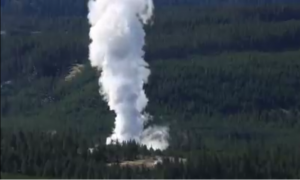The world’s largest active geyser has erupted three times in the past six weeks at Yellowstone National Park, including once this week, in a pattern that is unusual but not at all indicative of a more destructive volcanic eruption brewing beneath Wyoming, geologists said on Saturday.
Steamboat Geyser, which can shoot water as high as 300 feet (91 meters) into the air, erupted on March 15, April 19 and on Friday. The last time it erupted three times in a year was in 2003, the U.S. Geological Survey’s Yellowstone Volcano Observatory said.
The last time it erupted prior to March was more than three years ago in September 2014.
“There is nothing to indicate that any sort of volcanic eruption is imminent,” Michael Poland, the scientist in charge for the observatory, said in an email.
This year’s eruptions have been smaller than a usual Steamboat eruption, but the two in April were about 10 times larger than an eruption at the park’s famed Old Faithful Geyser in terms on the amount of water discharged, he said.
Geologists have not pinpointed a reason for the latest series of eruptions, but say they could indicate a thermal disturbance in the geyser basin, or that Steamboat may be having smaller eruptions instead of one large.
Since most geysers do not erupt on a regular schedule, “it might just reflect the randomness of geysers,” Poland said.
Only Waimangu Geyser in New Zealand has rocketed to greater heights than Steamboat, but not for more than 100 years, the U.S. National Park Service said.
Yellowstone sits atop a volcano that created a vast crater. Its plateau hosts the world’s most diverse and expansive continental hydrothermal systems, including the multicolored springs, mudpots and geysers for which the park is known.
While the Steamboat eruptions are unusual, what would be far more worrying would be the water in the hydrothermal systems drying up, which could indicate that the super hot magma deep below was making its way to the surface.
“Yellowstone hasn’t had a volcanic eruption for 70,000 years! Geysers erupt all the time,” said Jake Lowenstern, a USGS research geologist who specializes in volcanoes.
Source: yahoo
Ask me anything
Explore related questions





